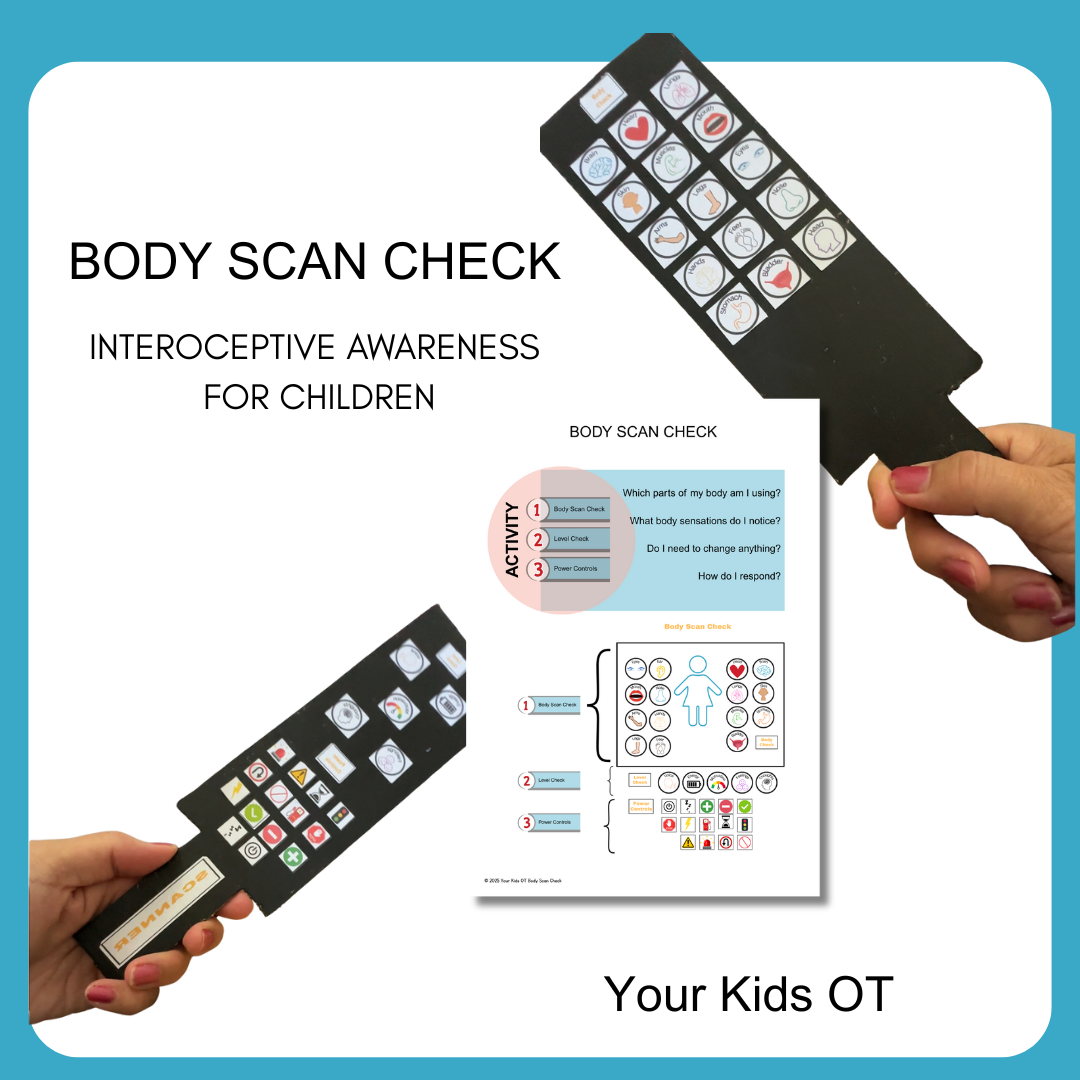Do you take part in any meditation or mindfulness activities for yourself?
Traditional mindfulness practices guide your still body to become aware of parts of your body. In turn you learn to relax muscles and let your mind ease.
This is really difficult. It is especially difficult for children who love to move, have racing thoughts and who have poor body awareness.
Body scan meditation is a mindfulness practice where attention is directed systematically to different areas of the body; noticing sensations such as tension, temperature or desires to move (or be still). This technique supports the development of interoceptive awareness—the ability to sense internal body signals—which plays a significant role in emotion regulation and mental well-being.
Occupational therapists use body scan meditation to help make the links between physical body experiences, recognising these signals or sensations and then responding to them to meet the individual’s needs. These needs could be physical (ie. recognising a growling tummy signals hunger and responding with eating, recognising a need a full bladder and responding by going to the toilet), emotional (ie. recognising tight muscles and a gripped jaw indicates rising anger and responding by taking a break) or cognitive/executive functioning (problem solving, planning, organising).
The following process has been inspired by insights from Mahler, K. (n.d.). Body Scan Meditation. Retrieved from Kelly Mahler’s official website
Step 1: Begin with Movement
While traditional body scan practices emphasize stillness, some children may benefit from starting with gentle movement. Light stretching, walking, or swaying can help increase bodily awareness in a way that feels grounding and manageable. Start with movements that you notice that your child is already doing.
Step 2: Focus on External Areas First
Start by paying attention to more tangible and accessible parts of the body, like the hands or feet. These areas are typically easier to connect with. Gradually, as comfort builds, shift your focus toward deeper or more subtle internal areas.
Step 3: Allow for Playful Exploration
Body awareness can be fun. Introduce small, playful movements to engage with your child in a lighthearted way. Use their interests, imagination and creativity.
Step 4: Notice and Describe Sensations
As your child scans through different body parts, help them to notice sensations that arise. Use descriptive language—“tingly,” “tight,” “warm,” “buzzing”—to label these experiences. Naming sensations supports the development of interoceptive awareness.
Step 5: Approach with Compassion and Flexibility
Some sensations may be uncomfortable or even triggering. It’s important to approach all sensations with a sense of kindness and curiosity. You can always skip an area and return later. Your child should feel safe to explore and discover thier own body.
By customizing body scan meditation to suit personal needs and preferences, this practice becomes a powerful tool for deepening awareness of the body’s internal landscape.
Mahler, K. (n.d.). Body scan meditation. Kelly Mahler Occupational Therapy, LLC. https://www.kelly-mahler.com/what-is-interoception/interoception-and-mindfulness/body-scan-meditation/
These pages have been designed to assist with developing your child’s interoceptive skills by using visual prompts, guided body scanning and response options.
This resource contains 5 sections …
Section 1: Visual resources for the overall process of body scanning and checking.
Make your own body scanner, use a poster version, a foldable version or use the worksheets to record body sensations.
Section 2: Parts of the body part focus.
Pay specific attention to parts of the body. Consider which parts of the body are used with movement. Develop language skills and an understanding of body sensations.
Section 3: Level check
Our inner drive and processes affect how we participate in activities. Our energy levels, use of our voice, motivation, feelings and thoughts can greatly impact engagement with a task. Just because we CAN physically do something does not mean that we WILL.
Section 4: Power controls
Power controls are prompts to guide responses to our body signals. A “supercharge body activity” sheet is included with activity ideas to assist with regulation. These are sensory based activities to provide proprioceptive input and build self awareness.
Section 5: Games and further activities.
This section contains a collection of “activities of daily living”. We need to do self-care tasks everyday and are encouraged to use the BODY SCAN CHECK technique with ADLs.
This section also includes “NAME” game and “MOVEMENT” game cards to build language, fostering connections with others as well as building body awareness. There are over 50 game cards with activity ideas.
Stay connected via Instagram for videos and a giveaway! I’ll be sharing details very soon, giving away three sticker versions of the BODY SCAN icons.
Until next time,














